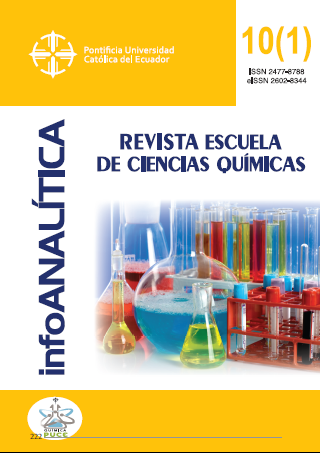ESTUDIO TEÓRICO Y COMPUTACIONAL DE LA PIRÓLISIS DEL 4-CLORO-1-BUTANOL EN FASE GASEOSA MEDIANTE LA TEORÍA DEL FUNCIONAL DE LA DENSIDAD
Contenido principal del artículo
Resumen
Se investigó el mecanismo y la cinética de la pirolisis en fase gaseosa del 4-cloro-1-butanol a nivel DFT. La reacción da como productos tetrahidrofurano, formaldehido, propeno y cloruro de hidrogeno. El mecanismo de eliminación molecular sugiere dos vías de reacción. La primera vía se produce a través de un estado de transición cíclico de cuatro miembros, donde el nivel de teoría WB97XD/6-31G++(d,p) mostró resultados cercanos con los parámetros cinéticos experimentales. La segunda vía ocurre en dos etapas, la primera se da mediante un estado de transición cíclico de cuatro miembros y la segunda con estado de transición cíclico de seis miembros, los niveles de teoría que dieron resultados más cercanos a los experimentales fueron B3LYP/6-31G(d,p) y WB97XD/6-31G++(d,p), para primera y segunda etapa respectivamente. La ruptura del enlace C-Cl, debido a su polarización en el enlace , es el paso determinante de la velocidad en ambas vías de reacción. El análisis topológico NCI se usó para determinar las interacciones no covalentes es todas las estructuras. La variación de la fuerza de los enlaces involucrados en las transiciones se midió mediante el índice IBSI, lo que permitió verificar el mecanismo propuesto
Descargas
Detalles del artículo
- Los autores se comprometen a respetar la información académica de otros autores, y a ceder los derechos de autor a la Revista infoANALÍTICA, para que el artículo pueda ser editado, publicado y distribuido.
- El contenido de los artículos científicos y de las publicaciones que aparecen en la revista es responsabilidad exclusiva de sus autores. La distribución de los artículos publicados en la Revista infoANALÍTICA se realiza bajo una licencia Creative Commons Reconocimiento-CompartirIgual 4.0 Internacional License.
Citas
Contreras-García, J., Johnson, E. R., Keinan, S., Chaudret, R., Piquemal, J.-P., Beratan, D. N., & Yang, W. (2011). NCIPLOT: A Program for Plotting Noncovalent Interaction Regions. Journal of Chemical Theory and Computation, 7(3), 625–632.
Chuchani G. (1995). The Chemistry of Halides, Pseudo-Halides and Azides, (Chapter 19), E.S. Patai and Z. Rapopport, eds, Wiley, New York, 1069.
Chuchani G. and Martín I. (1986). The elimination kinetics of methoxyalkyl chlorides in the gas phase. Evidence for neighboring group participation. J. Phys. Chem., 90, 431.
Chuchani, G., R.M. & Martín, I. (1987). Neighboring Group Participation in the Pyrolysis Kinetics of 4-Chloro-1-Butanol in the Gas Phase, Instituto Venezolano de Investigaciones científicas (I.V.I.C.).
Foresman B.J. & Frish Æ. (1996). Exploring chemistry with electronic methods, 2nd, Edition Gaussian Inc Pittsburg PA.
Gaussian NBO version 16., incluída en Gaussian 16.
Gaussian 16, Revision C.01, M. J. Frisch, G. W. Trucks, H. B. Schlegel, G. E. Scuseria, M. A. Robb, J. R. Cheeseman, G. Scalmani, V. Barone, G. A. Petersson, H. Nakatsuji, X. Li, M. Caricato, A. V. Marenich, J. Bloino, B. G. Janesko, R. Gomperts, B. Mennucci, H. P. Hratchian, J. V. Ortiz, A. F. Izmaylov, J. L. Sonnenberg, D. Williams- Young, F. Ding, F. Lipparini, F. Egidi, J. Goings, B. Peng, A. Petrone, T. Henderson, D. Ranasinghe, V. G. Zakrzewski, J. Gao, N. Rega, G. Zheng, W. Liang, M. Hada, M. Ehara, K. Toyota, R. Fukuda, J. Hasegawa, M. Ishida, T. Nakajima, Y. Honda, O. Kitao, H. Nakai, T. Vreven, K. Throssell, J. A. Montgomery, Jr., J. E. Peralta, F. Ogliaro, M. J. Bearpark, J. J. Heyd, E. N. Brothers, K. N. Kudin, V. N. Staroverov, T. A. Keith, R. Kobayashi, J. Normand, K. Raghavachari, A. P. Rendell, J. C. Burant, S. S. Iyengar, J. Tomasi, M. Cossi, J. M. Millam, M. Klene, C. Adamo, R. Cammi, J. W. Ochterski, R. L. Martin, K. Morokuma, O. Farkas, J. B. Foresman, and D. J. Fox. (2016). Gaussian, Inc., Wallingford CT.
Klein J., Khartabil H, Boisson, J.-C., Contreras-García, J., Piquemal J.-P. & Hénon E. (2020), New Way for Probing Bond Strength. J. Phys. Chem. A, 124, 1850-1860.
Maccoll A. (1969). Heterolysis and the pyrolysis of alkyl halides in the gas phase. Chem Rev., 69, 33.
Maccoll A. & Thomas P.J. (1955). A correlation between the rates of unimolecular pyrolysis of alkyl halides in the gaseous phase and sni rates in solution. Nature 176, 392.
Maccoll A. & Thomas P. J. (1967). Molecular reactions in the gas phase and the quasiheterolytic hypothesis. Prog. React Kinet., 4, 119.
Moyano A., Pericá M.A. & Valenti E. (1989). A theoretical study on the mechanism of the thermal and the acid-catalyzed decarboxylation of 2-oxetones (β-lactones). J Org Chem., 54, 573
Smith G.G. & Kelly F.W. (1971). Structure relationships in homogeneous gas-phase reactions: thermolyses and rearrangements. Progr. React. Kinet., 8, 75.
Scale factors in http: //cccbdb.nist.gov/vibscalejust.asp, (b) Database of Frequency Scaling Factors for Electronic Structure Methods https: //comp.chem.umn.edu/freqscale/index.html.
Tian L. & Feiwu Ch. (2012). Multiwfn: A Multifunctional Wavefunction Analyzer, J. Comput. Chem., 33, 580-592.
VMD - Visual Molecular Dynamics [Internet]. Ks.uiuc.edu. 2021.
Wiberg K.B., (1968). Application of the Pople-Santry-Segal complete neglect of differential overlap method to the cyclopropyl-carbinyl and cyclobutyl cation and to bicyclobutane. Tetrahedron. 24, 1083-1096.

